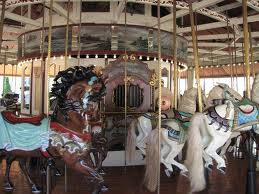Wurlitzer History Wurlitzer started in Cincinnati in 1856 by Franz Rudolph Wurlitzer (1831-1914). It was directed successively by his three sons, Howard, Rudolph, and Farny. From importing musical instruments it turned in the 1880s to marketing automated instruments, including disc-changer machines and coin-operated pianos. The "Mighty Wurlitzer" theatre organ was introduced in 1910, followed by the successful coin-operated phonograph, or juke-box (1934-74). In 1909 the company began making harps that were far more durable than European prototypes, and from 1924 to the 1930s eight acclaimed models were available.  The firm's violin department, independently directed by Rembert Wurlitzer (1904-63) from 1949, became a leading international centre for rare string instruments. Among Wurlitzer's electronic instruments, beginning with electric reed organs in 1947, the most important have been the fully electronic organs, especially the two-manual-and-pedals spinet type (from 1971 with synthesizer features) for domestic use. The Wurlitzer Company came to an end in 1988, when Wurlitzer was bought by the Baldwin Piano Company. Baldwin outsourced their Wurlitzer production and stopped placing the Wurlitzer name on pianos at the end of 2009. After the United States Government imposed high import tariffs on both street and fairground organ importation from 1892,[9] Wurlitzer began producing mechanical organs. Most were small barrel organs, playing from a pinned barrel and powered by either steam or cranked by hand. Many of these organs have cases finished in dark (and sometimes black) wood, with gold incised designs, not unlike those of the European manufacturers of barrel organs. As parts were not subject to import tariffs, almost all Wurlitzer band organs are in some way or another based on or latterly copied from a design by a European manufacturer. For example: the style 105 (and style 104) were copied from a Gerbruder Bruder barrel organ; the style 146 (the only difference being that the portions of the façade covering the drum wings were removed); the style 157 was copied from a Gavioli special style of organ (only 2 or 3 of this style of organ is known to exist; the former organ at Dorney Park was one, but it was destroyed in a fire); and the style 165 is copied from the Gerbruder Bruder "Elite Apollo Orchestra". As demand for organs grew from the fairground operators, Wurlitzer was approached by Eugene de Kleist, an-ex employee of Limonaire Frères and the founder of the North Tonawanda Barrel Organ Factory. After De Kliest developed the Tonophone for the company, which after winning a gold medal at the 1901 Pan-American Exposition, Wurlitzer invested in his company. After buying De Kliest out of the business in 1908, they changed the name of the factory to the Rudolph Wurlitzer Company. This allowed the company to invest in new technology, resulting in the adoption of electric motors, and the music source was changed from pinned barrels to perforated paper rolls similar to a player piano roll. Some larger organs such as the style 157 and style 165 have duplex roll frames, on which one roll plays while the other rewinds, allowing for continuous music. Each paper roll contained about 10 songs, but during the Great Depression, this was changed to 6 longer songs, in order to save money on arranging. The only substantial changes between these organs and the originals they were based upon is that the Wurlitzer models is that they operated on Wurlitzer's unique roll scale. These included the 46-note style 125 roll (used by styles 104, 105, 125, and smaller organs that saw less production), the wider 46-note 150 roll (used by styles 146, 153, and other less common mid-size styles), or the still wider 75-note 165 roll (used by styles 157, 165, and larger special organ models). Due to Wurlitzer's success and domination of the market, many smaller American manufacturers adopted scales similar to Wurlitzer's, but to little effect.  The production of Wurlitzer organs ceased in 1942, the last organ to leave the factory being a style 165 organ in a 157 case (done because Wurlitzer had an extra 157 case still in the factory and the owner didn't mind the change). During the Great Depression leading up to the end of production, various cost-cutting measures were made, such as the substitution of brass horn and trumpet pipes for ones made of wood (though arguably, the brass pipes produced a shrill and unpleasant sound, thus causing the change to the mellower wooden sound). Some orchestrions made by the company can be found at Clark's Trading Post, Lincoln, New Hampshire, USA, the Music Hall, Nevada City, Montana, USA, and the Jasper Sanfilippo Collection at Victorian Palace, Barrington Hills, Illinois, USA. The company's patents, trademarks and assets were acquired by the Baldwin Piano Company with their purchase of the keyboard division of Wurlitzer in 1988. |
|
PHONE: 860-261-5923 | EMAIL: sales@wurlitzerrolls.com
|
|


